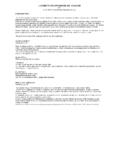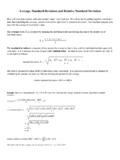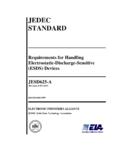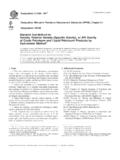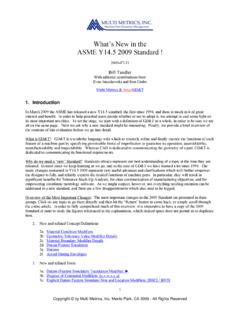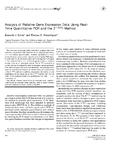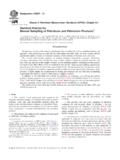Transcription of DISSIPATION FACTOR, POWER FACTOR, AND RELATIVE ...
1 DISSIPATION FACTOR, POWER FACTOR, ANDRELATIVE PERMITTIVITY (DIELECTRIC CONSTANT)By GrayTransformer Chemistry ServicesBackground:There is a relationship between the DISSIPATION factor, the POWER factor, and the permittivity or dielectricconstant. They all relate to the dielectric losses in an insulating fluid when used in an alternating electricfield. The permittivity is represented as a complex quantity in the following manner: e* = e'- j e" ; wheree* is the complex permittivity, e' is the real or measured permittivity, and e" is the imaginary the presence of an alternating field there is created a capacitance current and a resistive current that are90o out of phase with respect to each other.
2 The vector sum of these two currents represents the totalcurrent and the angle between the capacitance current vector and the resultant total current vector isdefined as the loss angle, d. The ratio of the imaginary to the real part of the permittivity is equal to tan d; tan d= e" / e'. The factor tan d is defined as the DISSIPATION factor, D, and represents the dielectric lossin the insulating fluid. The POWER factor, P, is defined as sin d. The relationship between D and P is thefollowing: D2- F2 = D2 F2, thus if you knowone value you can calculate the other. Furthermore for smallvalues of d, tan d ~ sin d, thus for values of tan d up to the POWER factor and the DISSIPATION factor arethe same within one part in a :The details of the entire procedure are given in the ASTM D 924 standard and are only briefly mentionedhere.
3 The measurements are made in specially designed cells that are machined to precise measurements are done at precise temperatures, usually 25 and 100oC, thus the cells have to be keptat a constant temperature. The actual measurement is one of comparing the capacitance of the cell filledwith the insulating fluid sample in a sensitive electronic bridge circuit. The result is usually expressed as apercentage forthe DISSIPATION factor or POWER :The dielectric loss factor relates to the inability of molecules in the insulating fluid to reorient themselveswith an alternating electric field. This ability is dependent on the temperature of thesample, the size ofthe molecules involved, and their polarity.
4 It is also dependent on the frequency of the alternating DISSIPATION factor and the permittivity are both affected by the molecular size, composition, andrelative orientation of functional groups within the molecules. In general within a series of similarmolecules, the permittivity will increase as the molecular weight increases. The above-described factorsare electrical characteristics of the insulating fluid and can be used to monitor the quality of the oil withregard to deterioration in use and for the presence of Factor TestThe POWER factor of insulating oil equals the cosine of the phase angle between an AC voltage applied tooil and the resulting current.
5 POWER factor indicates the dielectric loss of oil and, thus, its dielectricheating. The POWER factor test is widely used as an acceptance and preventive maintenance test forinsulating oil. Oil POWER factor testing in the field is usually done with the Doble type MH or M2H testset in conjunction with POWER factor tests of the oil-filled equipment. The POWER factor of new oil shouldnot exceed percent at 25oC. A high POWER factor in used oil indicates deterioration, contamination, orboth with moisture, carbon, varnish, Glyptal, sodium soaps, or deterioration products. Used oil with apower factor in excess of percent should be further analyzed in a laboratory to determine the cause ofthe high POWER factor.
6 Oil with a POWER factor in excess of percent may be an operational hazard. Itshould be investigated and either reconditioned or replacedThe IEEE has suggested guidelines for POWER factors depending on the type of oil and the unit it is beingused in (IEEE C57, 106-1991). Some representative values are given below:Type of Oil/UnitPower Factor@ 25oC@ 100oCShipment of New Oil from Refinerymax. Oil Received in New Equipment< or = 69 kV69- 288 kV> 345 kVmax. Oil for Circuit Breakersmax. Limits for Oil usedin Circuit Breakersmax. IEC has recommended Limits depending on the type ofType of equipment based on the IEC TestMethod 60247( DISSIPATION Factor @90 C)I E C 6 0 4 2 2 Table2 C ategor ,5kVanduptoandincluding170kV(otherthanth oseincategoryA).
7 CategoryCPowertransformers/ ,5kVandtractiontransformers(otherthantho seincategoryA).Oil-filledcircuitbreakers withanominalsystemvoltageexceeding72, , , , , DISSIPATION Factor IEC 60422 Recommended Action LimitsTransformersRecommended Action LimitsCategoryGoodFairPoorO, A< > , C< > < > < > is 10% DDFR ecommended ActionsO, A, B, CGood: Continue normal samplingFair: More frequent samplingPoor: Reclaim or replace the oilDRefer to manufacturer s best practiceCatastrophic failures have been reported at DDFIn VHV and EHV type D transformersERefer to manufacturer s best practiceResistivity at @20 CTransformersRecommended Action LimitsCategoryGoodFairPoorO, A>20020-200<20B, C>604-60<4D>800250-800<250E>607-60<7 Resistivity at @90 CCategoryGoodFairPoorO, A>101-10<1B, C> < >5010-50<10E> < are G MRecommended ActionsGood: Continue normal samplingFair: More frequent sampling.
8 Check other : Reclaim or replace the oilNote : Not a routine testTesting In Service Transformer Oil (Routine Monitoring Tests)When insulating fluid is subjected to an AC current, there are dielectric losses, which cause two resulting current is deflected slightly out of phase with the AC field that has been applied, and theenergy of the losses is dissipated as heat. Liquid POWER factor and the closely related DISSIPATION factor aredirect measure of these dielectric losses. (Liquid POWER factor is calculated as the sine of the loss angle-while the DISSIPATION factor is the tangent of the same loss angle)New, clean, and dry transformer oil has a very low value.
9 Contamination by moisture or by many othercontaminants will increase the liquid POWER factor. The aging and oxidation of the oil also elevates thevalues. Therefore this is an extremely useful test because almost everything bad that can happen to theinsulating oil will cause the liquid POWER factor to Transformer Maintenance Institute (TMI) has recommended In service values for all primary voltageclasses:Liquid POWER Factor ValuesAC(acceptable)QN(questionable)UN(u nacceptable)@25 C< > @ 100 C< > 100 C value is always considered more carefully than the 25 C when determining whether there is aproblem.
10 QN or UN values should be investigated and the cause diagnosed. Reclaiming (regenerating) theoil or hot oil cleaning the transformer will reduce the liquid POWER factor. Drying out the oil will improvethe 25 C METHODTan DeltaThis test is also known as the Loss Tangent or Dielectric DISSIPATION factor measurement. Tan delta may bedefined as the measurement of the cosine of the phase angle or the sine of the loss angle. It is basically themeasurement of the leakage current through the oil, whichin turn is a measure of the contamination ordeterioration of the oil.
